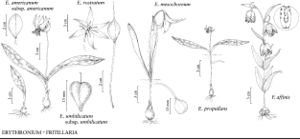Difference between revisions of "Erythronium umbilicatum subsp. umbilicatum"
IllustratedEndemic
imported>Volume Importer |
imported>Volume Importer |
||
| Line 49: | Line 49: | ||
|publication year= | |publication year= | ||
|special status=Illustrated;Endemic | |special status=Illustrated;Endemic | ||
| − | |source xml=https:// | + | |source xml=https://bitbucket.org/aafc-mbb/fna-data-curation/src/2e0870ddd59836b60bcf96646a41e87ea5a5943a/coarse_grained_fna_xml/V26/V26_273.xml |
|genus=Erythronium | |genus=Erythronium | ||
|species=Erythronium umbilicatum | |species=Erythronium umbilicatum | ||
Latest revision as of 22:14, 5 November 2020
Stolons absent. 2n = 24.
Phenology: Flowering spring.
Habitat: Woods of flood plains and adjacent slopes along creeks, streams, small rivers
Elevation: 0–900 m
Distribution

Ala., Fla., Ga., Ky., Md., N.C., S.C., Tenn., Va., W.Va.
Discussion
Since subsp. umbilicatum does not produce stolons, most plants in a population produce flowers, and seedlings may be frequent. Although many Erythronium species have considerable variation in size at flowering, E. umbilicatum subsp. umbilicatum is especially variable in this regard.
Selected References
None.
Lower Taxa
None.
